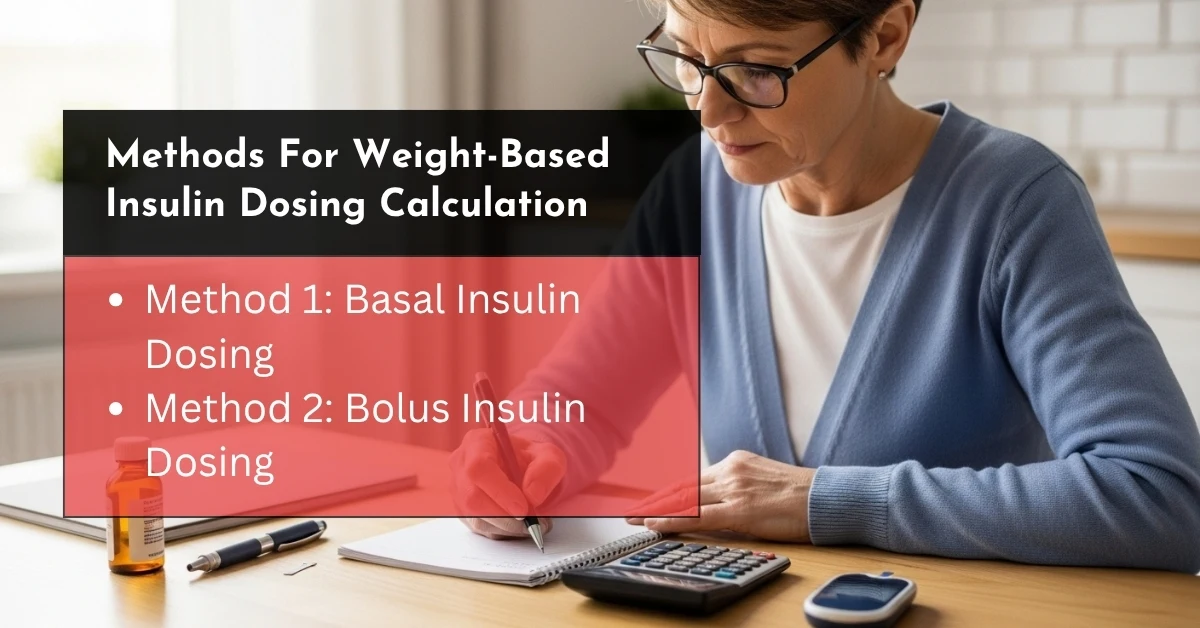
Starting insulin comes with a lot of feelings, but the main one is concern about whether the dose is too little or too much. For diabetic people who’re starting or adjusting insulin, the first step is accurate insulin dosing. To safely lower blood sugar without hypoglycemia, doctors use weight based insulin dosing. It estimates your total daily dose (TDD) using a simple formula where you need to divide your weight in pounds by 4.
With the correct CGM device and dosing method, you can track levels and make safe adjustments. Don’t have a monitoring sensor or CGM device? Go to Deliver My Meds to see if your insurance covers it! However, since the formula isn’t comprehensive, and there are other considerations to using extended-acting insulin as well as rapid-acting mealtime coverage. Learn why weight-based insulin dosing is the most secure method, particularly for those suffering from Type 2 Diabetes.
Why Weight Based Insulin Dosing Matters?
In reality, weight is the most precise aspect that is used to calculate a patient’s total daily dose of insulin (TDD) at the time of beginning insulin therapy or changing the level of insulin. Unlike reactive correction boluses or complex carb-counting methods, weight-based insulin dosing allows for a predictable, body-specific starting point, especially valuable in patients with type 2 diabetes or insulin resistance.
- The foundational formula is simple: Pounds ÷ 4 or kilograms × 0.55
For example, a 160-lb patient would receive approximately 40 units/day. This total is then divided into basal insulin dosing (approximately 40-50%) and mealtime insulin (50-60%) based on clinical judgment and glycemic targets.
Why Divide Weight By 4?
Dividing weight in pounds by 4 gives a safe starting insulin dose because it equals 0.25 units per pound. Clinical data show this keeps most patients below 0.6 units/kg per day, where hypoglycemia risk stays low. Multiple studies, like PubMed, confirm this range is both effective and safe when titrated based on glucose trends.
Methods for Weight-Based Insulin Dosing Calculation
Method 1: Basal Insulin Dosing (The Foundation)
Basal insulin dosing is the starting point. This long-acting insulin keeps your glucose steady between meals and overnight. Here we will cover kilograms calculations:
Typical starting range:
- 0.1 to 0.2 units/kg/day or 4 units/pound
- For insulin-resistant or obese patients: up to 0.5-0.6 U/kg/day
Example:
- 70 kg × 0.2 = 14 units/day
Pro Tip!
The most frequently used agent for basal therapy is insulin glargine. A standard insulin glargine dose calculation uses 0.2 units/kg/day, or a fixed dose of 10 units daily for initial titration. Doses are titrated every 3 days until fasting glucose stabilizes. Use sensors from DMM to see if your numbers rise between 2 am to 6 am, which may signal underdosing. If you’re dropping below 70 mg/dL at night, you’re likely over basal.
Method 2: Bolus Insulin (Mealtime and Corrections)
Once basal is set, insulin dosing continues with bolus insulin, given before meals or to correct high glucose. This is where most variability occurs, and where CGM feedback becomes essential.
You’ll calculate two parts:
1. Carb Ratio – The Rule of 500
500 ÷ TDD = grams of carbs covered per 1 unit of insulin
Example:
- TDD = 40
- 500 ÷ 40 = 1 unit per 12g carbs
2. Correction Factor – The Rule of 1800
This is used to determine “how much does one unit of insulin decrease blood sugar?”, also known as the insulin sensitivity factor (ISF). Rule of 1800 helps you calculate how much a single unit will lower your glucose:
- 1800 ÷ TDD = mg/dL drop per unit
Example: 1800 ÷ 40 = 1 unit lowers 45 mg/dL
Overall Insulin Dose:
Based on a TDD of 40 units, 20 units go to basal insulin dosing. The remaining 20 units cover meals and corrections. If eating 180g of carbs daily, you’ll need 15 units for food and 6-7 units for corrections. The final bolus dose would be 21-22 units. So, to calculate how much insulin you need daily, the standard calculation is:
Weight (kg) × 0.55 = Total Daily Dose (TDD)
Lastly, split it:
- 50% for basal insulin
- 50% for bolus/mealtime insulin
For type 2 diabetes, starting doses can range from 0.2 to 0.7 units/kg/day depending on resistance. For type 1, typical needs are 0.5-1.0 units/kg/day. Monitoring in real time is crucial to see whether you are underdosed, overdosed, or in range.
Understanding Insulin Units and Dosage
Insulin doses are highly individualized, but to know how many units of insulin are normal, here’s a table. This is only for estimated medical guidance; what’s “normal” for you depends on glucose patterns, weight, diet, and medications.
| Weight (kg) | Typical TDD (units/day) |
| 50 kg | 20-30 units |
| 70 kg | 28-42 units |
| 90 kg | 36-54 units |
What’s the Maximum Insulin Dose per Day?
Many diabetic patients ask, “Is 20 units of insulin a lot?” daily, and the answer is no. The normal range for diabetic patients is 20-55 units. There’s no fixed maximum insulin dose per day, but very high doses often signal resistance. Most providers reevaluate treatment when doses exceed 1 unit/kg/day. In type 2 diabetes, especially with obesity or steroid therapy, some patients may require 200-300+ units/day.
Note! Clarifying Dose vs. Injections:
The majority of people take between 1 and four insulin injections a day, based on the kind (basal or Bolus) and meal times. However, the number of shots is not equal to the total dose of insulin. For instance 20 units can be administered in one injection, or spread across several doses. Always ensure that you match the timing the type, amount, and timing to your sugar levels and, in the best case, use CGM assistance from DMM.
How to Determine Insulin Dose Safely
Safe insulin dosing starts with a structured approach. Keep these in mind:
- Begin with a weight-based insulin dosing formula (e.g., 0.2-0.6 units/kg/day).
- Apply the rule of 500 to estimate your carb ratio, and the rule of 1800 to calculate your insulin sensitivity.
- Use this data to split your total dose into basal insulin dosing and bolus insulin.
- A reliable insulin dose calculator by weight can help, especially when paired with CGM data.
- No calculation matters unless it reflects your real-life results. Continuous glucose monitors like the FreeStyle Libre 2, Libre 3, and Dexcom G6 show how your glucose responds to insulin, meals, and timing.
Final Thoughts on Personalizing Insulin Doses Based on Weight
Weight based insulin dosing offers a clinically supported way to initiate insulin therapy, especially in type 2 diabetes. But numbers alone are not enough, and real-time data completes the picture. With CGMs like the Libre 3 Sensor, you validate every dose, seeing whether 20 units of insulin is a lot or just right. When used with the right tools, insulin formulas help you calculate accurate bolus insulin doses for meals and correct high blood sugars.




